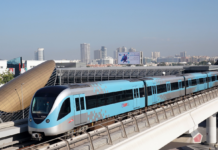By Bradley Hope www.thenational.ae
DUBAI // The inauguration of the Burj Khalifa is a crucial milestone in Dubai’s development. However, now that the remains of the fireworks have been brushed away and as visitors make their first trips to the observatory on the 124th floor, it is time to take a longer view on how development should progress.

Authorities have said the focus will be on infrastructure and finishing projects that have already started construction, which is wise. What else is needed is a comprehensive plan for development that sets out the priorities of construction and how the city can improve a sense of public life.
The economic slowdown has provided an important period to reflect and focus on the details of an urban hub that draws visitors from around the world.
With all pistons of the property economy firing, Dubai sprouted up in a scattershot manner over the past decade.
The result is one of the quickest build-up stories in the history of cities, but also a feeling that all the major locations in Dubai, from Deira to Downtown Burj Khalifa to the Marina, lack a sense of attachment.
Some parts of the city, such as Dubai Silicon Oasis and Festival City, feel isolated from the rest of the neighbourhoods except for a motorway access point.
The Metro, which opened in September, has gone a long way towards beginning to address this issue and its inauguration should be looked upon as a mirror achievement to the Burj Khalifa.
While the 828-metre tower is a symbol of imagination and human achievement, the Metro is the means to make Dubai a fluid, worthwhile place in which to make a home.
Indeed, Dubai has continuously broken the restrictions of its urban plans for development since as early as the 1960s, when the first master plan was created by the British architect John Harris for Sheikh Rashid bin Saeed Al Maktoum.
His plan, while humble, was also momentous for the small desert city. It was his designs that led to the first modernisations, including a road system and a new city centre.
Mr Harris kept expanding the plan into the 1980s as Dubai’s ambitions increased, especially with the discovery of oil in 1966.
The preeminent landmark from his time as an urban planner was the World Trade Centre, which was built in 1979 and would hold the record as the tallest building in the Middle East for 20 years.
It became apparent by the mid-1990s that the old blueprints were too small and Dubai introduced a 20-year plan in 1995 that laid out the basis for vast expansions of the city into the desert. Still, Dubai could not be constrained.
The plan called for buildings along the Sheikh Zayed Road to restrict their height to 30 storeys. The Burj Khalifa is more than five times that height.
More recently, the Australian firm Urbis was hired in 2007 to create a Dubai Urban Development framework, but nothing has come of that move despite plans to make an announcement at the end of 2008. The sudden slowdown of the property sector has led the Government to put the project under review.
That plan will be one of this year’s most important projects for Dubai. Not only must it bring order to a city that was growing by leaps and bounds, it must guide property development companies and municipal agencies to make decisions that will improve urban life.
Just down the E11 motorway, the Plan 2030 Abu Dhabi has become a source for the entire city to draw upon.
This foundational document has led to initiatives from paid parking to reduce congestion to new guidelines for curbing to make it easier and safer to walk down the street. When a new building is announced, it has to prove how it fits into the wider concepts for the area.
Dubai also has an opportunity to make its plan a truly public process. There is no more valuable resource in the emirate than its people, who walk the city every day and are familiar with the need for more public space and ease of transport. Ask an average resident and they will say they yearn for more spaces outside of shopping malls.
One of the best examples of this idea last year was The Walk at Jumeirah Beach Residence, which became the first truly outdoor, walkable space to be built in the property boom.
On a weekend and at night, you will always find large crowds (in the case of vehicle traffic, perhaps too large) cruising the street and families eating together at the cafes and restaurants along the boulevard.
Yasser Elsheshtawy, the author of Dubai: Behind an Urban Spectacle, says the current period of slower economic growth is a prime opportunity to focus on “creating a sense of place” through looking closer at pedestrian movements and incorporating historic areas into modern developments.
“There is a chance now to look at development in a more comprehensive manner,” he says. “The goal is a city people enjoy.”
Discussions among architects, urban planners, property brokers and developers have already started to move towards quality of life thanks to market forces.
With low demand for housing, the market has required each building to become more competitive to ensure it can rent out or sell enough apartments to make ends meet.
Yesterday marked the inauguration of the Dubai Forum, an event that brought together architects, journalists and thinkers to talk about “architecture for sustainable societies”.
Some of the panellists were direct in their criticism of the way cities have developed during periods of loose spending and unsustainable projects.
Dr Sabah al Rayes, the founder and managing partner of Pan Arab Consulting Engineers in Kuwait, drew loud applause when he said that only 5 per cent to 10 per cent of buildings were worth constructing.
“The rest is garbage, they are not sustainable,” he said. “We architects should really sit and evaluate our role in society.”
















